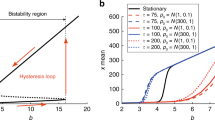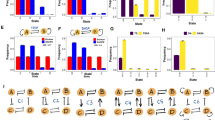Abstract
High-dimensional switches have been proposed as a way to model cellular differentiation, particularly in the context of basic Helix-Loop-Helix (bHLH) competitive heterodimerization networks. A previous study derived a simple rule showing how many elements can be co-expressed, depending on the rate of competition within the network. A limitation to that rule, however, is that many biochemical parameters were considered to be identical. Here, we derive a generalized rule. This in turns allows one to study more ways in which these networks could be regulated, linking intrinsic cellular differentiation determinants to extra-cellular cues.
Similar content being viewed by others
References
Bengal, E. et al., 1992. Functional antagonism between c-Jun and MyoD proteins: A direct physical association. Cell 68(3), 507–519.
Cherry, J., Adler, F., 2000. How to make a biological switch. J. Theor. Biol. 203(2), 117–133.
Cinquin, O., 2006. Addendum to high-dimensional switches and the modeling of cellular differentiation (submitted).
Cinquin, O., Demongeot, J., 2005. High-dimensional switches and the modelling of cellular differentiation. J. Theor. Biol. 233(3), 391–411.
Deed, R. et al., 1997. Regulation of Id3 cell cycle function by Cdk-2-dependent phosphorylation. Mol. Cell. Biol. 17(12), 6815–6821.
Ebert, P. et al., 2003. Zic1 represses Math1 expression via interactions with the Math1 enhancer and modulation of Math1 autoregulation. Development 130(9), 1949–1959.
Firulli, B. et al., 2003. PKA, PKC, and the protein phosphatase 2A influence HAND factor function. A mechanism for tissue-specific transcriptional regulation. Mol. Cell 12(5), 1225–1237.
Grinberg, A. Hu, C., Kerppola, T., 2004. Visualization of Myc/Max/Mad family dimers and the competition for dimerization in living cells. Mol. Cell. Biol. 24(10), 4294–4308.
Hara, E., Hall, M., Peters, G., 1997. Cdk2-dependent phosphorylation of Id2 modulates activity of E2A-related transcription factors. EMBO J. 16(2), 332–342.
Horwitz, M., 1996. Hypermethylated myoblasts specifically deficient in MyoD autoactivation as a consequence of instability of MyoD. Exp. Cell. Res. 226(1), 170–182.
Kuiper, R. et al., 2004. Regulation of the MiTF/TFE bHLH-LZ transcription factors through restricted spatial expression and alternative splicing of functional domains. Nucleic Acids Res. 32(8), 2315–2322.
Lim, J., Choi, K., 2004. Induction and autoregulation of the anti-proneural gene Bar during retinal neurogenesis in Drosophila. Development 131(22), 5573–5580.
Lluis, F. et al., 2005. E47 phosphorylation by p38 MAPK promotes MyoD/E47 association and muscle-specific gene transcription. EMBO J. 24(5), 974–984.
Mann, R., Affolter, M., 1998. Hox proteins meet more partners. Curr. Opin. Genet. Dev. 8(4), 423–429.
Massari, M., Murre, C., 2000. Helix-loop-helix proteins: Regulators of transcription in eucaryotic organisms. Mol. Cell. Biol. 20(2), 429–440.
Page, J. et al., 2004. MEKK1 signaling through p38 leads to transcriptional inactivation of E47 and repression of skeletal myogenesis. J. Biol. Chem. 279(30), 30966–30972.
Perry, R., Parker, M., Rudnicki, M., 2001. Activated MEK1 binds the nuclear MyoD transcriptional complex to repress transactivation. Mol. Cell. 8(2), 291–301.
Russell, R. et al., 2004. Id2 drives differentiation and suppresses tumor formation in the intestinal epithelium. Cancer Res. 64(20), 7220–7225.
Seo, S. et al., 2005. Geminin regulates neuronal differentiation by antagonizing Brg1 activity. Genes Dev. 19(14), 1723–1734.
Simone, C. et al., 2004. p38 pathway targets SWI-SNF chromatin-remodeling complex to muscle-specific loci. Nat. Genet. 36(7), 738–743.
Sloan, S. et al., 1996. Phosphorylation of E47 as a potential determinant of B-cell-specific activity. Mol. Cell. Biol. 16(12), 6900–6908.
Sriuranpong, V., et al., 2002. Notch signaling induces rapid degradation of achaete-scute homolog 1. Mol. Cell. Biol. 22(9), 3129–3139.
Suelves, M. et al., 2004. Phosphorylation of MRF4 transactivation domain by p38 mediates repression of specific myogenic genes. EMBO J. 23(2), 365–375.
Trott, R. et al., 2001. Drosophila melanogaster casein kinase II interacts with and phosphorylates the basic helix-loop-helix proteins m5, m7, and m8 derived from the enhancer of split complex. J. Biol. Chem. 276(3), 2159–2167.
Viñals, F. et al., 2004. BMP-2 decreases Mash1 stability by increasing Id1 expression. EMBO J. 23(17), 3527–3537.
Winter, B., Braun, T., Arnold, H., 1993. cAMP-dependent protein kinase represses myogenic differentiation and the activity of the muscle-specific helix-loop-helix transcription factors Myf-5 and MyoD. J. Biol. Chem. 268(13), 9869–9878.
Xiong, W., Ferrell, J., 2003. A positive-feedback-based bistable ‘memory module’ that governs a cell fate decision. Nature 426(6965), 460–465.
Yu, L. et al., 2005. Global assessment of promoter methylation in a mouse model of cancer identifies ID4 as a putative tumor-suppressor gene in human leukemia. Nat. Genet. 37(3), 265–274.
Zhou, J., Olson, E., 1994. Dimerization through the helix-loop-helix motif enhances phosphorylation of the transcription activation domains of myogenin. Mol. Cell. Biol. 14(9), 6232–6243.
zur Lage, P. et al., 2004. EGF receptor signaling triggers recruitment of Drosophila sense organ precursors by stimulating proneural gene autoregulation. Dev. Cell. 7(5), 687–696.
Author information
Authors and Affiliations
Corresponding author
Rights and permissions
About this article
Cite this article
Cinquin, O., Page, K.M. Generalized, Switch-Like Competitive Heterodimerization Networks. Bull. Math. Biol. 69, 483–494 (2007). https://doi.org/10.1007/s11538-006-9114-8
Received:
Accepted:
Published:
Issue Date:
DOI: https://doi.org/10.1007/s11538-006-9114-8




